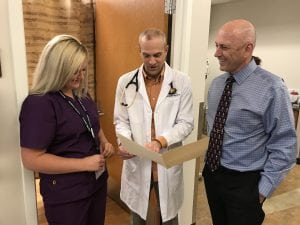In May 2017, Summit Pacific Medical Center become the first health care system in Washington State to hire a naturopathic physician as part of their primary care team. When Dr. Justin Taylor held a community meeting recently for people to learn more about what he does, it was a full house.
“We had more people attend that community health forum than any prior meeting,” said Summit Pacific Chief Medical Officer Dr. Ken Dietrich. “There’s been a tremendous patient interest in wanting to see a naturopath that’s integrated with a traditional primary care doctor. That’s been very encouraging for us to continue moving in this direction.”

The direction in question is an integrated care model, one that focuses more on collaborative and preventative care than the traditional fee-for-service system. “It’s a very different approach to managing patients,” says Dietrich. “It incorporates what the patient is interested in and what the team can come up with collaboratively. It’s personalized for each patient.”
To illustrate the difference, he describes the traditional pathway that patients generally follow in a segregated model. “Patients would visit their primary care doctor who might refer them to a specialist. If there were more than one issue, they might get referred to an internal medicine specialist or a physical therapist or chiropractor. Each one would do an assessment and make a recommendation. Information might be passed back and forth, but these are what we call ‘silos of care.’ There’s no integration.”
By contrast, at Summit Pacific, everything begins with an intake exam followed by a whole team evaluation. If the patient were a 25-year-old suffering from diabetes, hypertension and obesity, the team might recommend scheduling a wellness visit that would include a consultation with a primary care provider, dietician, a chiropractor and a naturopath for example.

After each visit, the team comes together for a roundtable assessment. “They build a road map,” says Dietrich. “It’s a day-by-day health care plan that could include traditional and alternative therapies such as medication, exercise, supplements and diet based on what the team develops based on the individual patient needs.”
The next stage involves the patient. Summit Pacific has Care Coordinators who work with individual patients to explain their options and track their progress. “The Care Coordinator will go over the team’s recommendation with the patient,” says Dietrich. “What do they want to do? What will they commit to? Then the coordinator stays in touch with them frequently with reminders and check-ins. For example, if there’s an upcoming course on how to make meals for diabetics, they’ll let the patient know.”
Changes in both the health care industry and public awareness make the model timely, he notes. “If you look at issues like obesity and diabetes over the last 50 years in America, their incidence is increasing and the traditional model has not been able to change that curve. Over the past 10 years, more people have become interested in a holistic approach to their health. The use of naturopathic and alternative therapies is increasing substantially.”

At the same time, insurance companies have been given a mandate by the government to change from a fee-for-service model to a system based on value and quality, say Dietrich. “Our primary mission is to improve the health of the community. Bringing in an integrated care model and helping one person at a time impact their health and their ability to live and function; that’s something they’ll communicate to their family and the community.”
Preventative care is particularly needed in Grays Harbor County which is often ranked among the lowest in the state in terms of population health. The normal ratio of primary care providers to patients is one provider for every 1,100 people, says Dietrich. However, in Grays Harbor the reality is one provider for every 2,600 people. Those factors played a role in the decision to create a new building devoted to patient wellness. “A large portion will be devoted to the integrated model,” he says. “This isn’t just some sort of trend we wanted to try. It involves the entire organization.” The building, which will house additional 60-80 employees, just broke ground and will be up and running in 2019.

As with any new program, staff responses to the integrated model have varied, but the overall reaction has been positive. “Many of our providers were involved in the process of strategic planning,” says Dietrich. “We have a mentoring program so any new provider that comes in gets mentored by one of our experienced leaders who helps them get integrated into the culture and understand care reviews. The staff are responding very nicely.”
Summit Pacific’s most recent provider retreat focused on integrative care. “It was led by a nurse practitioner who’s been doing it for a number of years. She talked about the data outcomes and their experience,” says Dietrich. “We’re going to continue to test and develop the model because ultimately we believe integrating and expanding healthcare options for our patients will provide them with the best possible choice for wellness.”
For more information visit Summit Pacific Medical Center online or call (360) 346-2222.
Sponsored













































